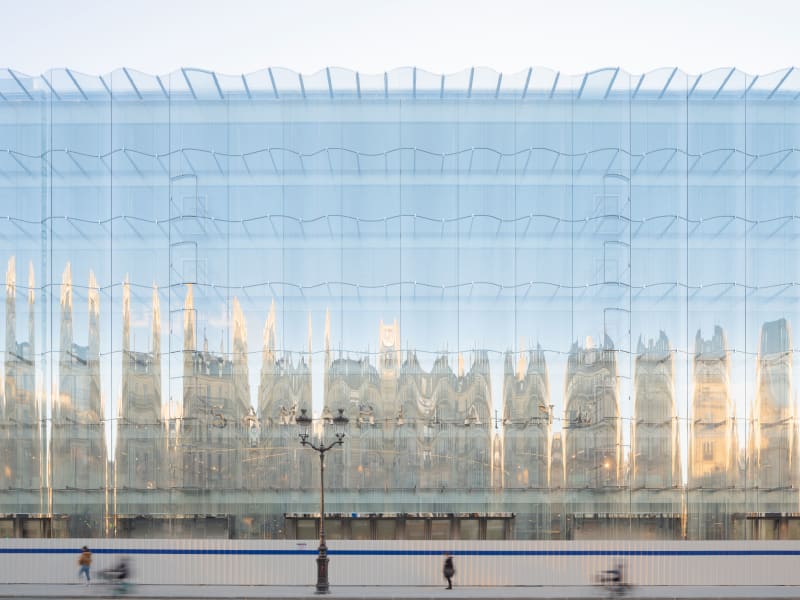SANAA architects studio was the head of the evocative restoration project of the Art Nouveau building Samaritaine Paris Pont-Neuf. The duo aims at accurately recreating its form, features and character while protecting its heritage value, yet it dares to encompass new design elements.
The renovation of La Samaritaine – le “Grand magasin” of the Belle Epoque in Paris – is of great historical significance as the blueprint of the project extends from Rue de Rivoli to the Quai du Louvre, overlooking the Seine. The iconic architecture, created by Ernest Cognacq and his wife back in the late XIXth century, is now back to its former glory.
The founders of Sanaa firm, Kazuyo Sejima and Ryue Nishizawa, created a new passage, patios with open-sky effect and envisioned a new architectural volume whose translucent, rippled glass façade reflects the past and present in a constant dialogue with the opposite buildings.

Architects Frantz Jourdain and Henri Sauvage had shaped the concept of an innovative shopping destination where everything was within reach. A century later the guru of luxury brands, Bernard Arnault with LVMH embarked on the great adventure to turn this fading temple into a contemporary wonder (more than that, it is a place of experiences).
Samaritaine had to close its doors in 2005 for safety reasons. Today, this project of almost 30.000 msq adds to the neighborhood transformation, which is prone to become a green heart of the capital (partly pedestrianized) and feature art galleries, hotel de charme and residential units.
The cooperation with japanese SANAA architects studio is at the roots of the aesthetic and technical value of the project. The long and exhausting renovation process (which lasted almost 17 years) resulted in the epitome of creativity and respect for the existing historical landscape.
READ ALSO – Casa Batlló : the shrine designed by Antonio Gaudì in Barcelona
Contemporary architecture has thoroughly renovated the high-end department store which reflects the spirit of the time and the city surrounding it. The stunning wavy glass façade in Rue de Rivoli embodies the theatrical soul of the project, visitors may reach the Seine and the Pont-Neuf along an internal “bridge” dotted with trees and patios with glass skies. The exciting challenge was to harmonize the different layers of styles where Art Nouveau meets Art Deco architectural heritage, revealed by meticulous restoration and rising to a climax in the spectacular glass roof and splendid mounted canvases.
SANAA design connects three full height courtyards (one existing and two new ones): each boasting a unique personality and together they create an alternating sequence of indoor activity areas and open spaces with idyllic sky-viewing. This new Paris passage is both a physical and figurative connection between the historical façade of the Sauvage building overlooking the Seine and the new façade they have designed.
The Rivoli façade revitalizes the image of La Samaritaine: the soft waves of the glass echo the rhythm and scale of neighboring fenestration, establishing continuity along this busy commercial street. To further enhance the integration of the new design within its urban context the glass reflects and transforms the surrounding environment, creating a subtle combination of the historical and the contemporary across its surface. “Our intention is to establish a harmonious relationship between those parts that are renovated and those that are new” told the architect.
Primary elements of this renovation are the restored glass roof and its Eiffel structure by Francis Jourdain, the peacock fresco by Francis Jourdain surrounding the glass roof considered one of the masterpieces of Art Nouveau, the restored 675 linear meters Art Nouveau facade and the Grand staircase made of 16,000 gold leaves, the Art Nouveau ceramics and the 270 original oak steps.
Canadian studio, New York based, Yabu Pushelber added a touch of their contemporary “zest” highlighting the Eiffel structure and its luminosity while bringing their chic, warm style to almost all floors of the Pont-Neuf building. Visitors can enjoy an intimate, exclusive shopping experience, full of surprises and discoveries. In terms of materials, Yabu Pushelberg has chosen noble materials (such as the terrazzo finish which evokes the Parisian cobblestones). The agency also designed the furniture and rugs exquisitely coordinated with bronze and touches of symbolic grey-blue from the original decor.
Listone Giordano refined wood surfaces and floor have been selected to be a consistent element of the interior design layout.
Source: www.sanaa.co.jp